Chapter 10: Muscular System (Gross Anatomy)/Chapter 9: Muscular System (Histology and Physiology)
0.0(0)
Card Sorting
1/141
Study Analytics
Name | Mastery | Learn | Test | Matching | Spaced |
|---|
No study sessions yet.
142 Terms
1
New cards
Tendons
attach muscle to bone
2
New cards
Aponeurosis
A broad, flat tendon
3
New cards
Origin/head of a muscle
muscle end attached to the more stationary spot
4
New cards
Insertion of a muscle
muscle end attached to the bone that moves when the muscle contracts
5
New cards
Belly of a muscle
the largest portion, between the origin and insertion
6
New cards
Agonist
muscle that causes an action
7
New cards
Antagonist
muscle that acts in opposition to agonist
8
New cards
When you are doing the flexion motion of a biceps curl, what muscle is the agonist? What muscle is the antagonist?
Biceps are the agonist, triceps are the antagonist
9
New cards
Synergists
muscles that work together
10
New cards
Examples of synergists muscles
biceps brachii & brachialis = elbow flexion
11
New cards
Quadrangular muscle shape
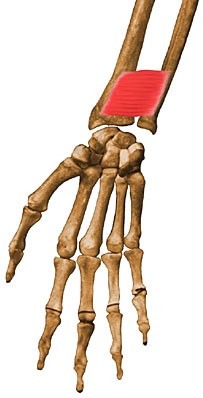
12
New cards
Rhomboidal muscle shape
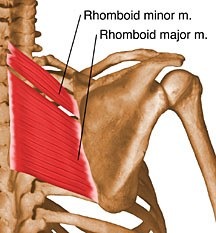
13
New cards
Fusiform muscle shape
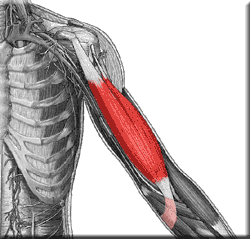
14
New cards
Trapezium muscle shape
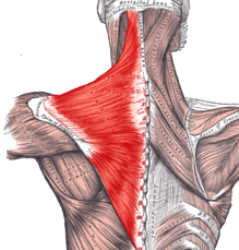
15
New cards
Triangular muscle shape

16
New cards
Digastric muscle shape
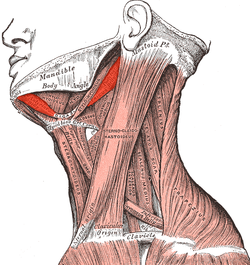
17
New cards
Bicipital muscle shape
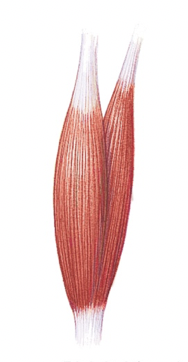
18
New cards
Muscles are named according to: (7 things) LSSOONF
1. Location: pectoralis, gluteus, brachial.
2. Size: maximus, minimus, longus, brevis.
3. Shape: deltoid, quadratus, teres.
4. Orientation: rectus.
5. Origin and insertion: sternocleidomastoid, brachioradialis.
6. Number of heads: biceps, triceps.
7. Function: abductor, adductor, masseter (chewer).
2. Size: maximus, minimus, longus, brevis.
3. Shape: deltoid, quadratus, teres.
4. Orientation: rectus.
5. Origin and insertion: sternocleidomastoid, brachioradialis.
6. Number of heads: biceps, triceps.
7. Function: abductor, adductor, masseter (chewer).
19
New cards
Muscular system functions (7 things)
1. Body movement.
2. Maintenance of posture.
3. Respiration.
4. Production of body heat.
5. Communication.
6. Constriction of organs and vessels.
7. Heartbeat.
2. Maintenance of posture.
3. Respiration.
4. Production of body heat.
5. Communication.
6. Constriction of organs and vessels.
7. Heartbeat.
20
New cards
Contractility
muscle shortens with force
21
New cards
Excitability
respond to a stimulus
22
New cards
Extensibility
muscle can be stretched beyond its normal resting length and still contract
23
New cards
Elasticity
recoil to original resting length after stretched
24
New cards
Comparison of skeletal, smooth, and cardiac muscle

25
New cards
Each skeletal muscle =
a complete organ
26
New cards
Muscle cells are associated with
connective tissue, blood vessels, & nerves
27
New cards
Skeletal muscle fibers develop from
myoblasts
28
New cards
Number of skeletal muscle fibers are
"constant" from birth.
29
New cards
Which of these is not a major functional characteristic of muscle?
A. Contractility
B. Elasticity
C. Excitability
D. Secretability
A. Contractility
B. Elasticity
C. Excitability
D. Secretability
D. Secretability
30
New cards
Which of these is true of skeletal muscle?
A. Spindle-shaped cells.
B. Under involuntary control.
C. Forms the walls of hollow organs.
D. Many peripherally located nuclei per muscle cell.
A. Spindle-shaped cells.
B. Under involuntary control.
C. Forms the walls of hollow organs.
D. Many peripherally located nuclei per muscle cell.
D. Many peripherally located nuclei per muscle cell.
31
New cards
What is a group of muscle fibers called?
a fasciculus
32
New cards
4 layers of connective tissues coverings of skeletal muscle (SEPE)
Starts with the muscle fiber, then goes:
1. Sarcolemma
2. Endomysium
3. Perimysium
4. Epimysium
1. Sarcolemma
2. Endomysium
3. Perimysium
4. Epimysium
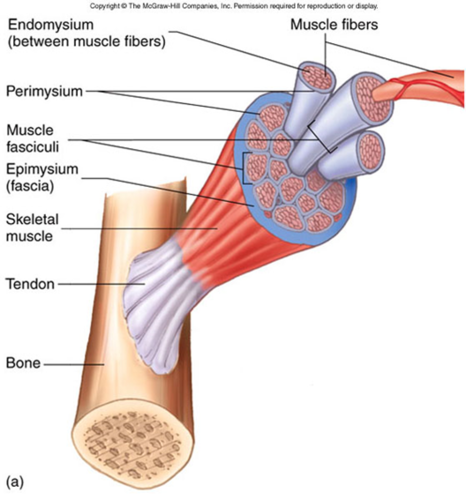
33
New cards
Sarcolemma
surrounds the muscle cell (example: plasma membrane of muscle fiber)
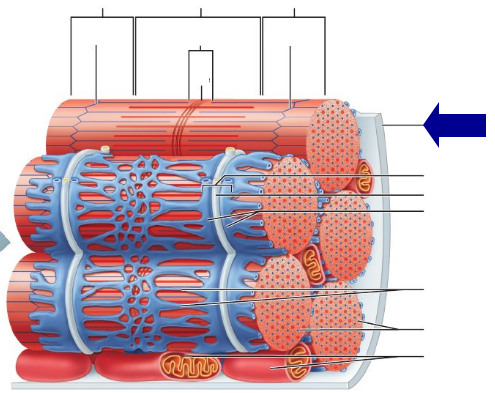
34
New cards
Endomysium
Also around muscle cell
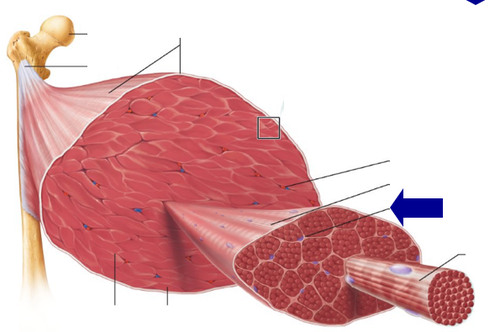
35
New cards
Perimysium
Denser C.T. surrounding fasciculus
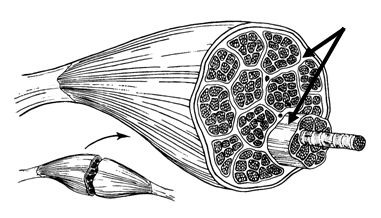
36
New cards
Epimysium
C.T. that surrounds the muscle (many fasciculi make up muscle)

37
New cards
Fascia
connective tissue sheet in muscles that is continuous with tendons and periosteum
38
New cards
Functions of fascia (4 things)
1. Forms layer under the skin.
2. Holds muscles together - separates them into functional groups.
3. Allows free movements of muscles
4. Carries nerves (motor neurons, sensory neurons), blood vessels, and lymphatics
2. Holds muscles together - separates them into functional groups.
3. Allows free movements of muscles
4. Carries nerves (motor neurons, sensory neurons), blood vessels, and lymphatics
39
New cards
Motor neurons
stimulate muscle fibers to contract
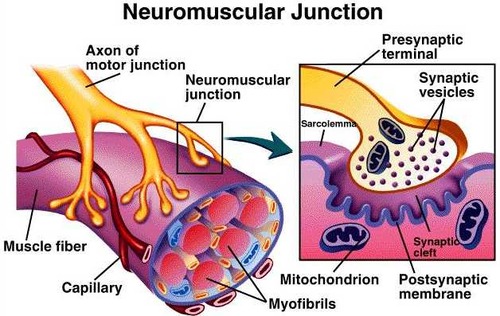
40
New cards
Structure of motor neurons
Neuron cell bodies are in brain/spinal cord, then branched axons attach to skeletal muscle fibers
41
New cards
Each muscle fiber is
innervated
42
New cards
Muscle fiber anatomy
Nuclei is inside sarcolemma, and the muscle cell is packed with myofibrils within the sarcoplasm
43
New cards
Sarcoplasm
muscle cell cytoplasm
44
New cards
Myofibrils
groups of myofilaments
45
New cards
2 types of myofibrils in a muscle fiber
1. Actin myofilaments
2. Myosin myofilaments
2. Myosin myofilaments
46
New cards
Actin myofilaments
THIN threadlike, protein threads (letter R in picture)
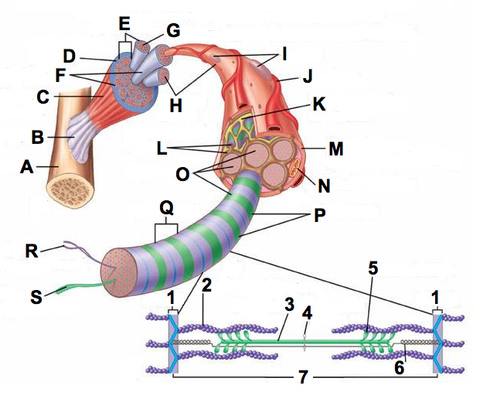
47
New cards
Myosin myofilaments
THICK threadlike, protein threads
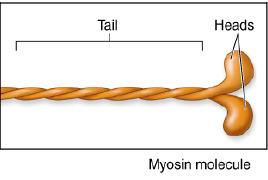
48
New cards
Sarcomeres (Z disk to Z disk)
basic structural & functional repeating unit of skeletal muscle (because it is the smallest portion of skeletal muscle capable of contracting) that is the attachment site for actin myofilaments
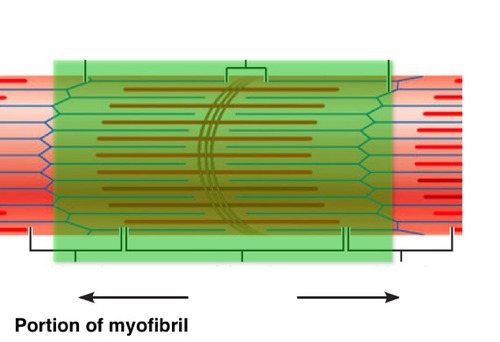
49
New cards
Z disk
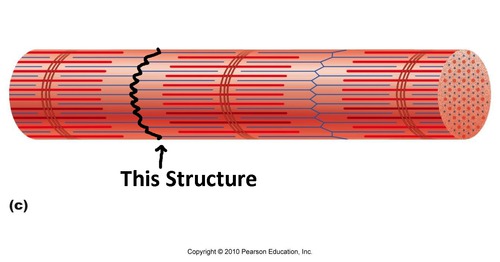
50
New cards
F actin
a fibrous protein made of a long chain of G actin molecules strung together and twisted into a helix
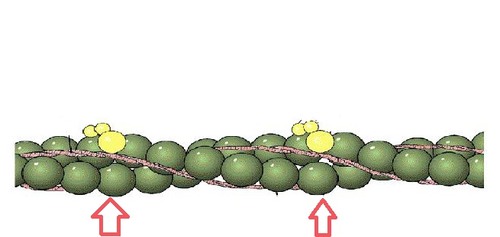
51
New cards
Tropomyosin
a long protein that covers active binding sites on actin to prevent myosin from binding

52
New cards
Troponin
a globular protein complex that has 3 subunits that bind to the actin, tropomyosin, and Ca++
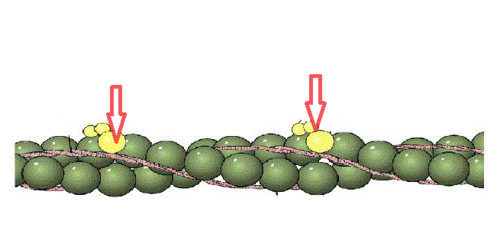
53
New cards
What does the tropomyosin/troponin complex do?
regulates active sites on G actin and myosin
54
New cards
How do myosin heads work? (2 steps)
1. Binds to active sites on actin - forms cross-bridges
2. Breaks down ATP (with ATPase Enzyme) releasing energy used to bend hinge region
2. Breaks down ATP (with ATPase Enzyme) releasing energy used to bend hinge region
55
New cards
Muscle fiber striated appearance is cause by (4 things) IAM and H
1. I bands - ends of myosin
2. A bands - length of myosin
3. M line - filaments holding myosin in place
4. H zone - only myosin, no overlapping actin
2. A bands - length of myosin
3. M line - filaments holding myosin in place
4. H zone - only myosin, no overlapping actin
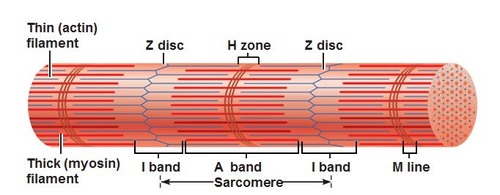
56
New cards
Which myofilament is the thick one?
A. Actin
B. Myosin
C. Troponin
D. Tropomyosin
A. Actin
B. Myosin
C. Troponin
D. Tropomyosin
B. Myosin
57
New cards
Does actin or myosin change length when the muscle contracts?
No
58
New cards
Relaxation: sarcomeres lengthen by _________ muscles.
antagonistic
59
New cards
Sarcomere shortening
During contraction, Z disks are brought closer together as the actin myofilaments at each end of the sarcomere slide past the myosin toward each other. The H zones (yellow) and the I bands (blue) narrow. In a fully contracted muscle, the ends of the actin myofilaments overlap at the center of the sarcomere and the H zone disappears.
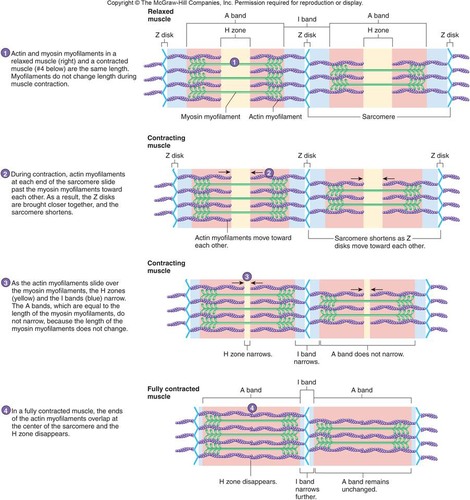
60
New cards
Physiology of skeletal muscle fibers includes: (3 things)
1. ion channels
2. action potentials
3. neuromuscular junction (NMJ)
2. action potentials
3. neuromuscular junction (NMJ)
61
New cards
Action Potential Phases
1. Membrane at resting potential (R.P.) then voltage hits absolute threshold because of a stimulus
2. Depolarization
3. Repolarization
4. Hyperpolarization
5. Back to R.P.
2. Depolarization
3. Repolarization
4. Hyperpolarization
5. Back to R.P.
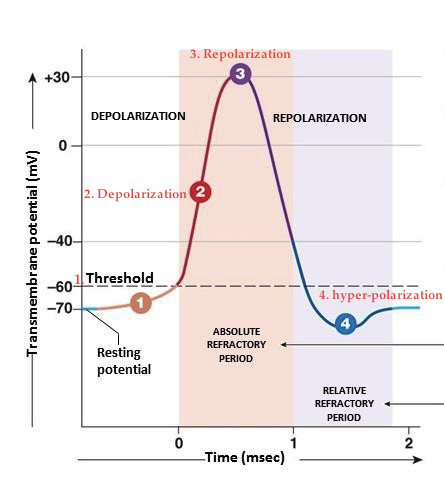
62
New cards
During the depolarization phase of an action potential, the permeability of the plasma membrane to
A. Na+ decreases
B. K+ increases
C. Ca++ decreases
D. Na+ increases
A. Na+ decreases
B. K+ increases
C. Ca++ decreases
D. Na+ increases
D. Na+ increases
63
New cards
Which direction does Na+ travel during depolarization?
A. Into the cell.
B. Out of the cell.
C. It doesn't go much of anywhere.
D. It goes to Hulsey Wellness Center.
A. Into the cell.
B. Out of the cell.
C. It doesn't go much of anywhere.
D. It goes to Hulsey Wellness Center.
A. Into the cell.
64
New cards
Synapse of a NMJ
axon terminal resting in a depression of the sarcolemma
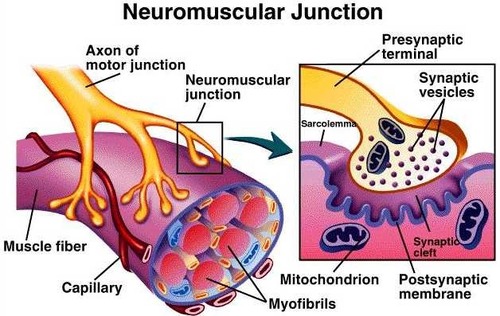
65
New cards
Another name for postsynaptic membrane
motor end-plate
66
New cards
What does acetylcholine do?
stimulates/inhibits action potentials in the postsynaptic membrane
67
New cards
Acetylcholinesterase
Degrading enzyme in synaptic cleft that prevents accumulation of acetylcholine
68
New cards
Acetylcholinesterase is an important molecule in the neuromuscular junction because it
A. Stimulates receptors on the presynaptic terminal.
B. Stimulates receptors on the postsynaptic membrane
C. Breaks down acetylcholine.
D. Causes the release of Ca++ from the sarcoplasmic reticulum.
A. Stimulates receptors on the presynaptic terminal.
B. Stimulates receptors on the postsynaptic membrane
C. Breaks down acetylcholine.
D. Causes the release of Ca++ from the sarcoplasmic reticulum.
C. Breaks down acetylcholine.
69
New cards
Excitation-contraction coupling
The Mechanism where an action potential causes contraction of a muscle fiber
70
New cards
Excitation-contraction coupling involves (5 things)
1. Sarcolemma
2. Transverse (T) tubules: depression in the sarcolemma
3. Terminal cisternae of the Sarcoplasmic reticulum (smooth ER)
4. Ca2+
5. Troponin
2. Transverse (T) tubules: depression in the sarcolemma
3. Terminal cisternae of the Sarcoplasmic reticulum (smooth ER)
4. Ca2+
5. Troponin
71
New cards
Relaxation process (3 things)
1. Ca2+ moves back into sarcoplasmic reticulum by active transport, which requires energy. (Diffusion of Ca2+ out of Sarcoplasmic Reticulum is rapid, but active transport of Ca2+ back into the Sarcoplasmic Reticulum is slow in comparison.)
2. Ca2+ moves away from troponin-tropomyosin complex.
3. Tropomyosin complex re-establishes its position and blocks binding sites on actin again.
2. Ca2+ moves away from troponin-tropomyosin complex.
3. Tropomyosin complex re-establishes its position and blocks binding sites on actin again.
72
New cards
What is the neuromuscular junction?
the axon terminal and the area of the sarcolemma they innervate
73
New cards
Given these events for muscle contraction:
1. Sarcoplasmic reticulum releases Ca++
2 Sarcoplasmic reticulum takes up Ca++
3. Ca++ ions diffuse into the cytoplasm where the myofibrils are located.
Choose the correct order.
1. Sarcoplasmic reticulum releases Ca++
2 Sarcoplasmic reticulum takes up Ca++
3. Ca++ ions diffuse into the cytoplasm where the myofibrils are located.
Choose the correct order.
1, 3, 2
74
New cards
What happens if something destroys (or blocks) the acetylcholine receptor site in the neuromuscular junction?
myasthenia gravis
75
New cards
Myasthenia gravis
an autoimmune disease where muscles have flaccid paralysis (are weak) because of the destruction of the ACh receptors by antibodies
76
New cards
Muscle twitch phases
1. latent/lag
2. contraction
3. relaxation
2. contraction
3. relaxation
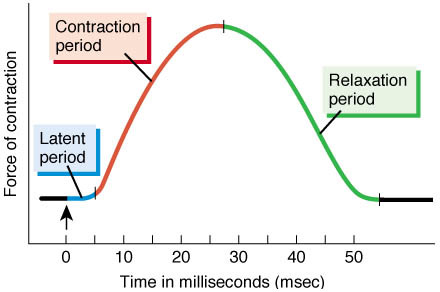
77
New cards
Motor unit
a single motor neuron and all muscle fibers innervated by it.
78
New cards
Summation
increasing the force of contraction of the muscle fibers within the muscle
79
New cards
Recruitment
increasing the number of muscle fibers contracting
80
New cards
Multiple motor unit summation
increased force of contraction
because more motor units are
Stimulated
because more motor units are
Stimulated
81
New cards
the amount of tension is determined by
the amount of motor units responding
82
New cards
Muscle tetany
sustained muscle contraction
83
New cards
As the frequency of action potentials increase, the frequency of contraction increases until
tetanus is achieved
84
New cards
Incomplete tetanus
muscle fibers partially relax between contractions
85
New cards
Complete tetanus
no relaxation between contractions, with very rapid AP's
86
New cards
Isotonic muscle contraction
tension is constant, and has change in length (ex: upper limb movement, fingers typing)
87
New cards
Isometric muscle contraction
tension increases, and no change in length (ex: postural muscles of body)
88
New cards
Most muscle contractions are not strictly isotonic or isometric.
True, for example walking
89
New cards
Concentric muscle contraction
(Isotonic) Tension is great enough to overcome opposing resistance and muscle shortens (ex: loaded backpack off the floor - as muscle shortens tension increases
90
New cards
Eccentric muscle contraction
(Isotonic) Tension is maintained but opposing resistance lengthens the muscle (ex: lower a heavy weight)
91
New cards
Muscle tone
constant tension by muscles over a long time that keeps back and lower limbs straight, head upright, abdomen flat
92
New cards
Choose the correct statement.
A. Isometric: change in length and tension.
B. Isometric: no change in length but the tension increases.
C. Isotonic: no change in length but the tension increases.
D. Isotonic: change in length and tension.
A. Isometric: change in length and tension.
B. Isometric: no change in length but the tension increases.
C. Isotonic: no change in length but the tension increases.
D. Isotonic: change in length and tension.
B. Isometric: no change in length but the tension increases.
93
New cards
Fatigue
decreased capacity to work and reduced efficiency of performance
94
New cards
3 types of fatigue
1. Psychological
2. Muscular
3. Synaptic
2. Muscular
3. Synaptic
95
New cards
Psychological fatigue
Perceives can't/but can! (Involves CNS, most common, and depends on emotional state of individual.)
96
New cards
Muscular fatigue
results from ATP depletion. (ex: marathon runners, swimmers,
2nd most common
2nd most common
97
New cards
Synaptic fatigue
occurs in NMJ due to lack of acetylcholine (occurs in cases of extreme exertion, rarely occurs)
98
New cards
Rigor Mortis
muscles become rigid several hours after death
99
New cards
Why does Rigor Mortis happen?
Low levels of ATP and the breakdown of the SR Membrane cause Ca2+ to leak into sarcoplasm, which causes the myosin heads to attach to actin cross bridges. Then because of a low ATP concentration (shortly after death ATP production stops) myosin can't let go.
100
New cards
When does Rigor Mortis end?
when tissues deteriorate